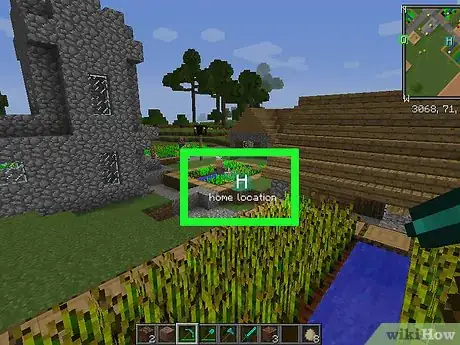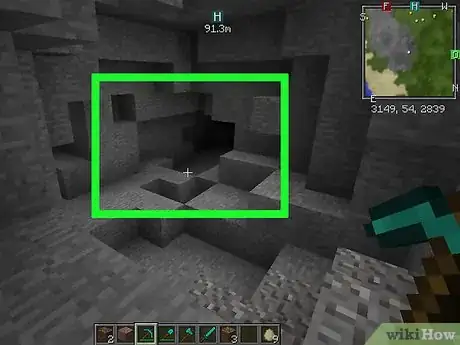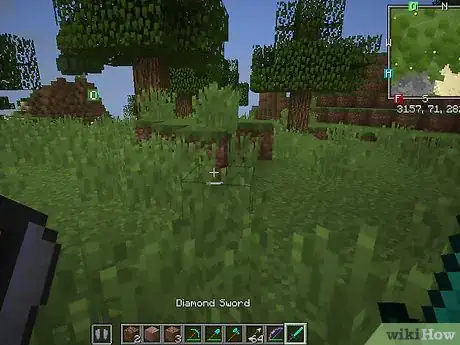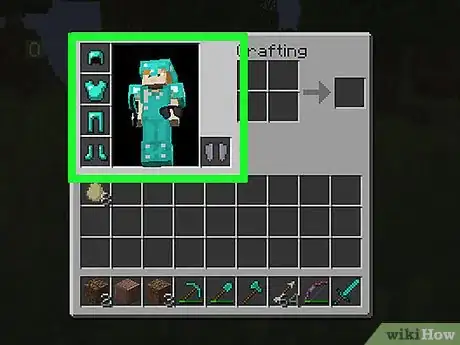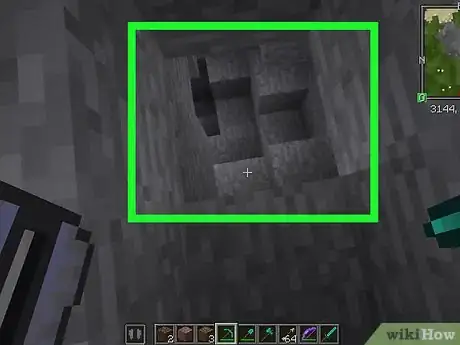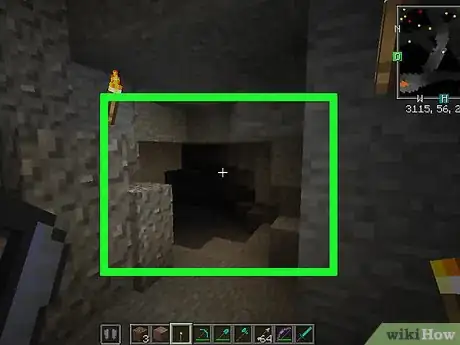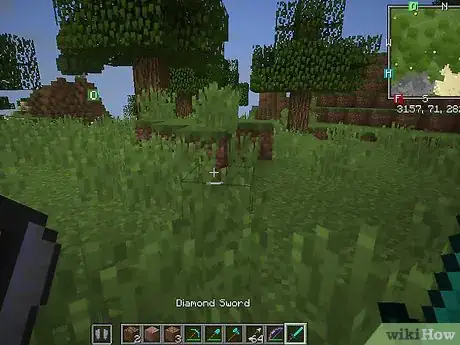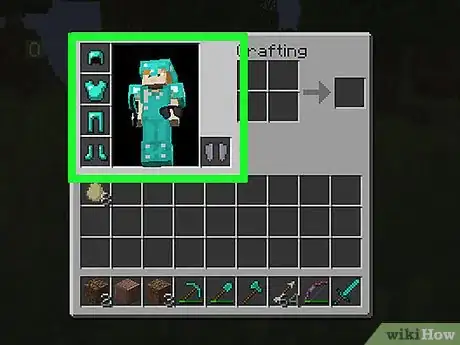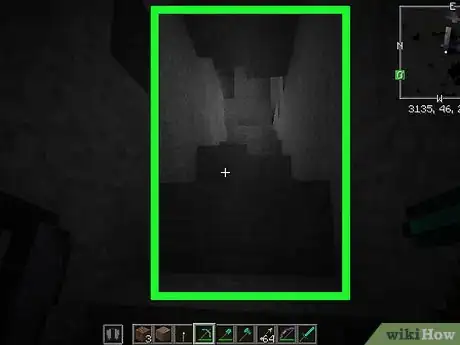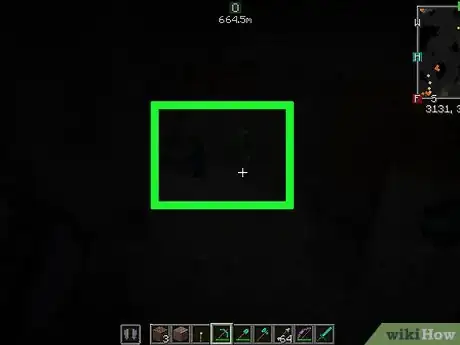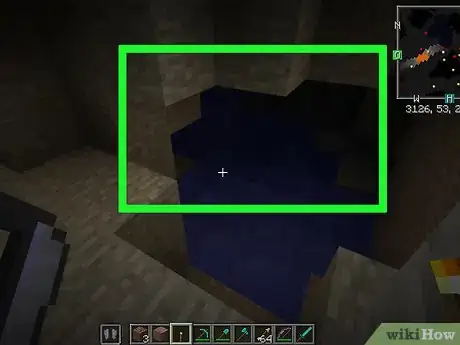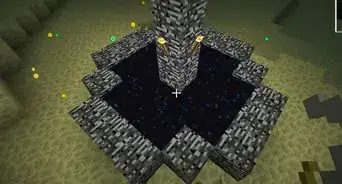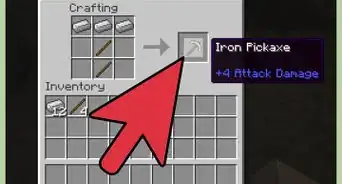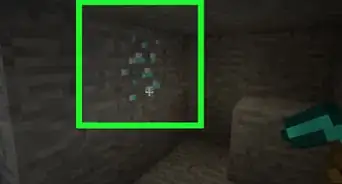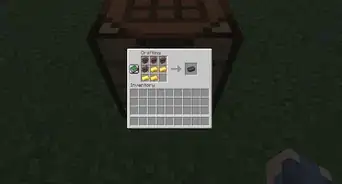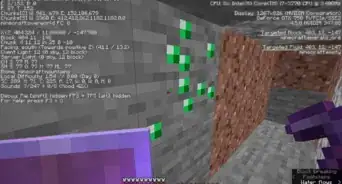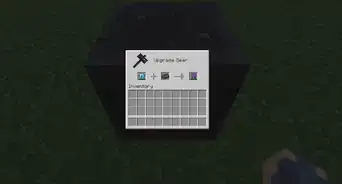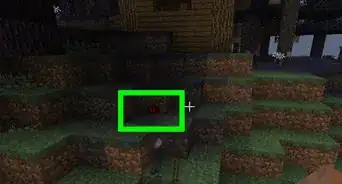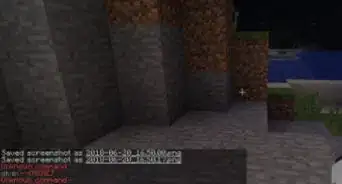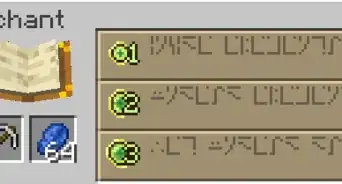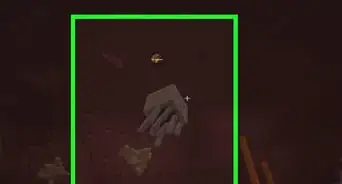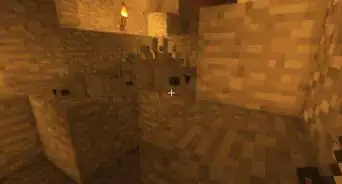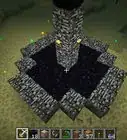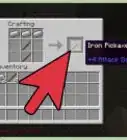X
wikiHow is a “wiki,” similar to Wikipedia, which means that many of our articles are co-written by multiple authors. To create this article, volunteer authors worked to edit and improve it over time.
This article has been viewed 44,493 times.
Learn more...
A cave (or cavern) is a type of area found in Minecraft that are underground and often contain either valuable or highly useful resources. Though they frequently hold many dangers, such as creepers, cave spiders, zombies, skeletons, and endermen, they also contain gold, diamonds, and emeralds that will make exploring them worth the risk. Each player has their personal preference about locating and then mining caves, but with preparation, finding a cave can be a breeze.
Steps
Method 1
Method 1 of 3:
Finding Caves through Surface Exploration
-
1Gear up. You never know where a cave in Minecraft is going to take you, or where exactly you could end up while exploring. Caves are some of the most dangerous areas in the whole game, and it's important you have all the essential items you need for survival before you set out.
- Weapons: Some players like avoiding combat whenever possible while others seek it out. No matter your preference on this, it's a good idea to bring at least one weapon with you just in case. The easiest weapons to craft are swords and a bow and arrow. Swords are a bit easier to get the hang of while bows can do ranged damage. You can either take both, or choose the one that best fits your preferred playing style.
- Armor: This is completely optional, but it can prevent you from taking as much damage should you find yourself in combat, and that can mean the difference between life and death. You can have a helm, a chest piece, and boots all equipped at the same time, and the best part is that it doesn't even take up inventory space.
- Torches: These are probably the most important item to have with you if you plan on entering a cave. Since caves are underground, they often contain areas that are either poorly lit or not lit at all, so you'll need to be able to provide your own lighting. Bring a lot of torches, and keep a stack in your item bar for easy access.
- Pickaxes: Caves are primarily made of stone, so it's a good idea to have a couple pickaxes on you just to help you get around. Caves will also have a lot of good resources that you'll need a pickax in order to mine.
- Bucket of water/bucket: Depending on what exactly you're aiming to find in the cave, it can be useful to carry a bucket of water with you. You can pour water onto lava, which not only neutralizes the lava as a threat but will also create obsidian. Alternatively, an empty bucket will allow you to pick up water from its spawn point, which can sometimes make it easier to explore areas of a cave that would otherwise be flooded or waterlogged.
- Food: You could be out exploring for a while, and if you're successful in finding a cave, you could be out even longer. While caves are rich in many resources, they're not good for finding food, so you'll want to bring your own. You want to keep your fullness meter filled because that will ensure that you are able to regenerate any health that you might lose along the way.
-
2Learn the location of your base. The last thing you want to do is lose the way back to your base, so before you leave you need to make sure you know exactly where you're at. If getting lost is still something you're worried about, there are a couple options to ensure you'll be able to find your way back.
- If there are any memorable land formations or decorations you've added around your base, be sure to take note of that so you have something to look for.
- Leaving a trail can be a good way to not get lost. You can put down torches, or even decorative blocks like flowers, and then follow the trail back to your base when it's time to return.
- Using a map is also an option if you either have one already or have the tools needed to craft one. Maps are a great way of knowing where you are in relation to your base.
Advertisement -
3Set out. Some caves are exposed, meaning that they have entrances you can find just by walking around the surface. Walk in any direction you like, keeping in mind not to get lost, and keep an eye out for caves.
- Exposed cave entrances are usually stone and are most typically found in the mountain biomes.
- Exposed caves will often have at least one ore block near the entrance, so you can be tipped off if you see a lot of coal or iron while you're walking, and you should investigate.
- Don't just look for caves, listen for them. In addition to the ambiance music that plays when you get close to a cave or a cave entrance, you can also frequently hear monsters making noise from the cave, and sometimes you can hear lava and waterfalls as well.
Advertisement
Method 2
Method 2 of 3:
Finding a Cave by Digging Down
-
1Pick a location. One of the benefits of looking for caves by digging is that you can decide where to put the entrance, picking somewhere that is convenient for you.
- When choosing a location, it's probably best to pick somewhere near your base so that you won't have very far to travel when you're going between your cave and your base.
- You can put your cave entrance inside your base if you want, and then you don't have to go outside when you're trying to return, which could be dangerous, particularly if you're exiting the cave at night.
- If you plan on putting your cave entrance inside your base, you might want to either seal it off or mark it so that you don't just have an open hole that you could risk falling into.
-
2Gear up. Preparing yourself to tunnel down into a cave is a little bit different than just looking for a cave. If you're digging into one, your entrance is somewhere that you picked and is probably a lot easier to find than a naturally exposed cave entrance. This means that it will be a lot more convenient to get supplies. Instead of preparing yourself for what you'll find in the cave, you just need to have the supplies needed to make the entrance.
- Torches: Since you'll be digging down, you're going to run out of natural light very quickly, so it's important that you have lots of torches so you can see what you're doing. It's not going to be very easy to get lost this way, but if it's too dark you won't be able to see if you come across any valuable materials that would be worth mining.
- Ladders: Ladders are made from sticks, and while they're not the only method of getting back up once you've dug this hole, they are definitely the most efficient.
- Pickaxes: Since you'll be coming across a lot of stone as you dig, it's important that you have at least a couple pickaxes with you. They'll also be important to have if you find anything to mine along your way.
- Shovels: While you don't technically need shovels, there's a good chance you'll come across either dirt or gravel on your descent, and shovels will really speed up the process for moving those blocks.
-
3Dig down. Simply begin your descent by making sure your pickax is highlighted (or shovel if the blocks your mining are dirt) and left-clicking on the block you want to remove and holding down the left mouse button until the block is gone.
- Keep in mind: you never ever want to dig straight down from the block that you're standing on. Although it's one of the quickest ways to tunnel downward, it's also the most dangerous and can result in the death of your character.
- If you happen to be tunneling toward a cave ceiling and you remove the block you're standing on, you would fall and could take a lot of damage. You could also tunnel yourself into lava.
- Instead of digging straight down, you'll need to make your entrance two blocks wide. Stand on one of the blocks as you dig the other and switch back and forth. That way if you remove a block that is directly above either nothing or lava, you can stop, climb out of the hole, and find another place to dig.
- Put down ladders as you dig. To do this, you simply make sure that the ladder section in your toolbar is highlighted and right-click on the block where you'd like to place it. You can highlight the slot that an item is in either by scrolling to it with your mouse wheel, or pressing the number that corresponds to that slot. (If your ladders are in your third item slot for instance, you'll want to press the 3 on your keyboard to highlight that item.)
- Since you're going to have to use ladders to get out of the hole and back to your base, it's important that you put them down as you dig deeper and deeper. It's easier to put them down as you're dig than as you're climbing, and this will also make sure you don't run short on ladders.
- If you run out of ladders at any point, you should resurface and make some more before continuing your descent, as running out of ladders could get you stuck.
- In addition to putting down ladders, you should also be putting down torches. It's a good idea to put torches on the opposite wall of your ladder as this will offer the best visibility.
- You won't need to put a torch on every block, just put them down when you feel that your surroundings are getting too dark. You need to be able to see as it will help you avoid falling should you find a cave.
- You can easily put torches on the wall just like you would with a ladder, making sure that your torches are highlighted from your toolbar and then right-clicking where you'd like to place it.
- Keep in mind: you never ever want to dig straight down from the block that you're standing on. Although it's one of the quickest ways to tunnel downward, it's also the most dangerous and can result in the death of your character.
-
4Don't get discouraged. Digging straight down like this will only lead you directly into a cave about 50% of the time. If you keep digging down all the way until you hit bedrock (which is the bottom layer and impossible to dig past) and you still haven't found a cave, don't worry. You haven't wasted your time, and you can still find what you're looking for.
- Keep listening. If you hear anything as you're climbing up and down on your ladder, it could be a sign that you're near a cave. You can often hear monsters, water, lava, and ambiance music to let you know when you're close. If you hear anything, you can start tunneling in the direction that it's coming from, which should lead you to a cave.
- If you don't hear any cave sounds, then the best tactic is to tunnel straight in any direction from 10–12 layers above the bedrock. Go all the way to the bottom of the hole you dug and place down 9 blocks directly beneath you. Start tunneling from there.
- The reason for this is that the most valuable resources usually spawn in the layers 10–12 blocks above bedrock, so searching for a tunnel from this point will not only lead you to a cave, but it also has the best chance of leading you to a cave with gold and diamonds.
Advertisement
Method 3
Method 3 of 3:
Finding a Cave by Digging Diagonally
-
1Pick a spot to start digging. Much like with digging straight down, you can choose where the entrance to your cave starts. It's good to pick somewhere that is easy for you to find and is either connected to your base or close by. That way you can avoid getting lost and you have easy access to your base when you're returning from mining the cave once you've found one.
- When you're digging down diagonally, you're essentially creating a staircase that goes straight into the cave. For this reason, it's a good idea not to create the entrance inside your base without blocking it off, or adding some kind of barrier since enemies would be able to follow you back up from the cave.
-
2Gear up. Like with digging straight down, it's most important that you just focus on the tools needed to get you to the cave, not the tools you'll need once you're in the cave. This is because it's much easier to return to your base to restock on supplies. These are the most essential tools to bring when looking for a cave in this fashion.
- Pickaxes: Most of the blocks in between you and the cave you're looking for are going to be stone, so you're going to need one very durable pickax at the least.
- Torches: While this method can sometimes provide more light than digging straight down, you're still going to be underground, and torches are still going to be extremely useful.
- Shovel: You'll most likely encounter a lot of dirt blocks and a lot of gravel blocks, which can be tedious to move out of the way by hand. Though a shovel isn't required, bringing one could save you a lot of time.
- Food: Digging out steps into the ground is a lot more time consuming than just digging a hole, so you might want to bring some food to help keep your fullness meter up.
-
3Start digging. Like with any aspect of Minecraft, there are a lot of personal preferences involved in how you want to dig. If you tend to get claustrophobic while playing, for instance, you may want to make your staircase more than a single block wide and make the ceiling above each of your steps higher. There is no wrong way to do it, but here are a few things to keep in mind.
- You need to have at least three blocks of blank space above each of your steps in order to be able to get up and down the stairs smoothly.
- The wider your staircase is, the more time it's going to take to dig out, but the easier it's going to be to find, and the more ground you'll cover. You should weigh those thoughts before deciding what you're comfortable with.
- If you're building any structures where you'll be using a lot of cobblestone, a wider staircase will help you collect more of it to work with.
- If you're hoping to find a cave more quickly, a single block staircase is going to get you to one the fastest, and might be a better option for you.
- If you're unsure of how wide you'd like your staircase, you can always start small and then expand later if you find yourself wanting more space, or wanting your entrance to be easier to find.
- Signs are also a great way to mark your stairs so you don't lose them from inside the cave and are a faster alternative to making a wide, easily visible staircase.
-
4Stay attentive. If you have to dig down any length of time before you find a cave or anything of interest, it can get tedious, but you need to pay attention for the following things:
- Music: When you're near a cave, there's ominous music that will play. If you hear the music before finding a cave, it might mean that you're right next to a cave and should start heading in that direction.
- Water/lava: You can hear both running water and lava when you're close enough to them. If you hear the sound of rushing water, it would be a good idea to mine in that direction. If you hear the sound of lava, it probably does mean there's a cave nearby, but you should exercise more caution when mining in that direction to avoid actually touching any lava.
- Monsters: Monsters such as skeletons and zombies will make noises that you'll be able to hear through a couple blocks, so if you hear them, digging in their direction will most likely lead you to a cave, but prepare yourself for combat before heading in that direction.
-
5Find a cave. This is the most effective method for cave finding. If you reach bedrock, and still have not located a cave, there are a number of options of where to go from there.
- When you hit the bedrock, you can ascend until you're 10–12 blocks above that and keep mining. 10–12 blocks above bedrock is where things like diamonds and gold naturally spawn, and they're most commonly found at the bottom level of the biggest caves, so this is a good place to continue your search at.
- You can always start this process over, digging yourself another staircase from a different starting point.
- Another option would be to continue forward, and dig yourself a staircase that goes up, the opposite direction from the way you came in.
- If you're tired of digging, you can always resurface and try to find an exposed cave entrance.
Advertisement
Community Q&A
-
QuestionCan I find a cave in a single Minecraft day?
 MapleyCommunity AnswerIt is possible. Caves are randomly generated. You can spot them fairly easily from an elevated area. Head to a mountain or hill, and look around for a stony pit in the earth.
MapleyCommunity AnswerIt is possible. Caves are randomly generated. You can spot them fairly easily from an elevated area. Head to a mountain or hill, and look around for a stony pit in the earth. -
QuestionCan I find more than 7 diamonds in 1 vein?
 VortrexionTop AnswererYou can find up to 16 diamonds in one vein. This is because when diamonds generate, they may overlap in veins, resulting in two veins of 8 forming a single vein of 16 diamonds.
VortrexionTop AnswererYou can find up to 16 diamonds in one vein. This is because when diamonds generate, they may overlap in veins, resulting in two veins of 8 forming a single vein of 16 diamonds. -
QuestionWill a monster cave (Monster spawner cave) have things like gold, diamonds, iron, coal?
 Seasalt25Top AnswererDungeons, the cobblestone areas with mob spawners, may have chests that contain coal, iron ingots, gold ingots, and redstone dust. You can't find diamonds in them, but you can find diamond horse armor.
Seasalt25Top AnswererDungeons, the cobblestone areas with mob spawners, may have chests that contain coal, iron ingots, gold ingots, and redstone dust. You can't find diamonds in them, but you can find diamond horse armor.
Advertisement
About This Article
Advertisement

